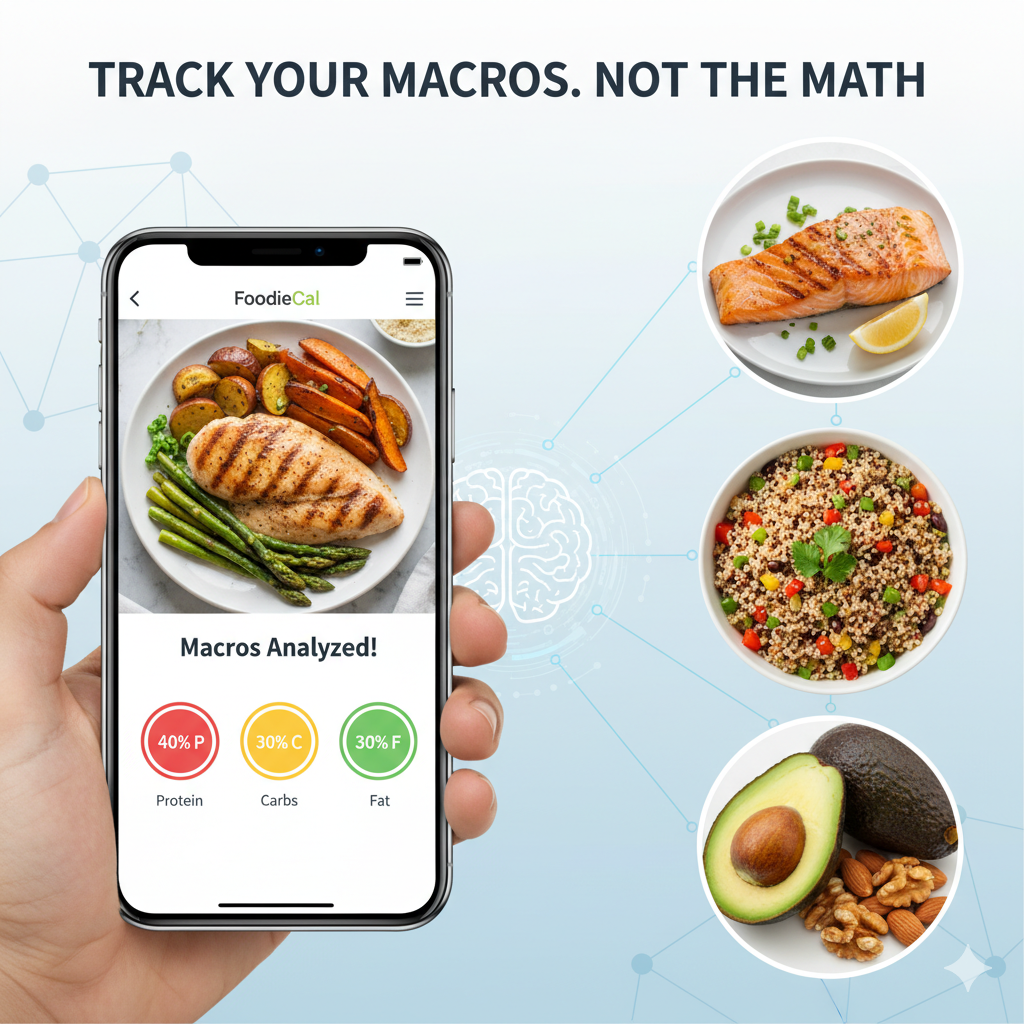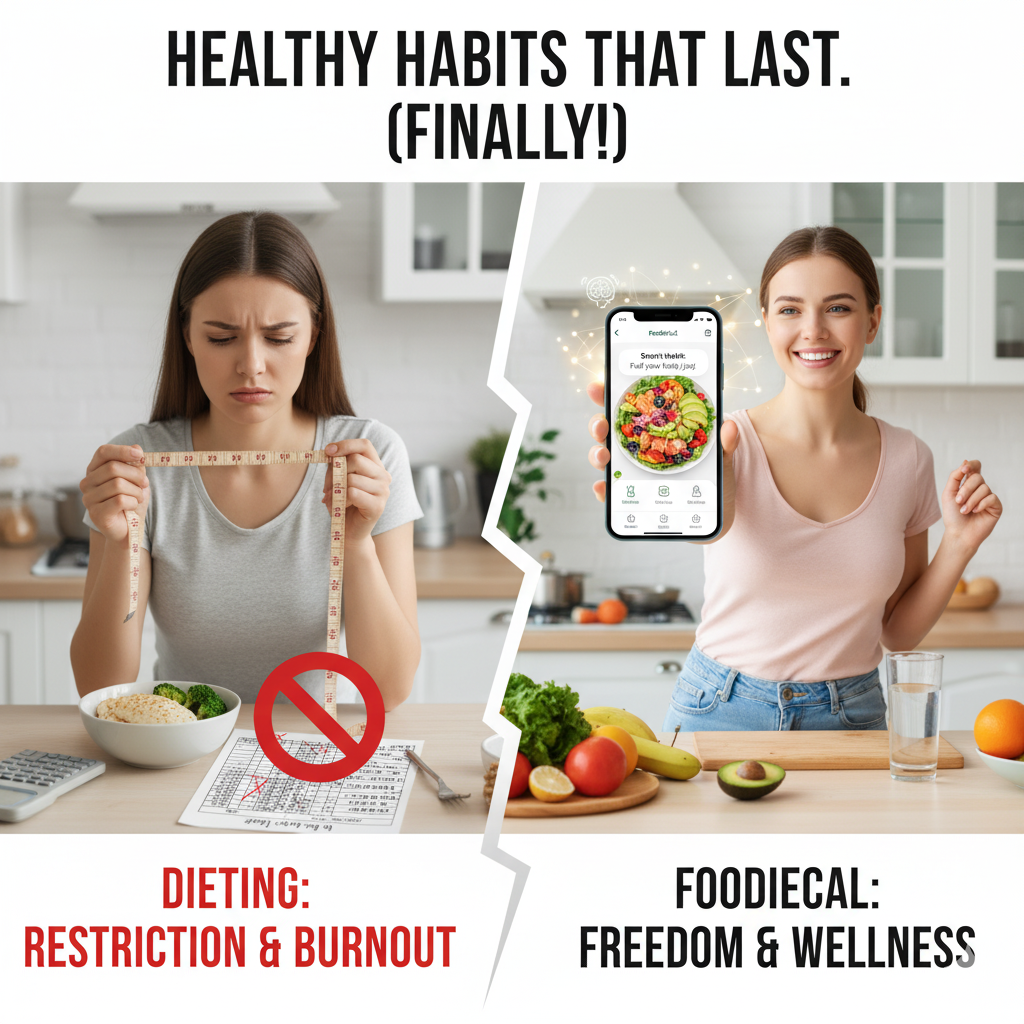

You’ve probably heard the term “macros” thrown around at the gym or in health articles. It’s often mentioned by people who seem to get amazing results, whether their goal is to lose fat, build muscle, or just feel more energetic.
But let’s be honest: “tracking your macros” sounds complicated. It sounds like math, spreadsheets, and a lot of work.
It used to be.
The good news? It’s not anymore. This guide will break down everything you need to know, from the “what” and “why” to the “how”—and we’ll show you how to do it all without a single calculator.
Part 1: What Are Macros?
“Macros” is short for macronutrients. These are the three main nutrients that your body needs in large (hence, “macro”) amounts to function. Every food you eat is a combination of them.
- PROTEIN (The Builder): This is the building block for your body. It repairs muscle, builds new tissue, and is essential for hair, skin, and nails. It’s also very satiating, which means it helps you feel full and satisfied.
- Found in: Chicken, beef, fish, eggs, tofu, lentils, yogurt.
- CARBOHYDRATES (The Fuel): This is your body’s primary and most easily accessible energy source. Your brain, muscles, and central nervous system all run on carbs (in the form of glucose).
- Found in: Bread, pasta, rice, fruits, vegetables, oats.
- FATS (The Regulator): Fats get a bad rap, but they are absolutely essential. They regulate hormones, protect your organs, and help your body absorb certain vitamins (like A, D, E, and K). They also provide a long, slow-burning source of energy.
- Found in: Avocado, olive oil, nuts, seeds, butter, fatty fish.
Part 2: Why Track Macros (Instead of Just Calories)?
This is the most important question. A calorie is a unit of energy, but not all calories are created equal.
Your body treats 100 calories from a donut (mostly carbs and fat) very differently than 100 calories from a chicken breast (mostly protein).
- **If you only track calories, you’re only seeing how much you’re eating.
- If you track macros, you’re seeing what you’re eating.
This “what” is the key to changing your body composition.
For Weight Loss: Prioritizing protein while staying within your calorie goal helps you stay full, which reduces cravings. This ensures you’re losing fat, not the muscle underneath.
For Muscle Gain: You need to eat enough protein to repair and build new muscle tissue. You also need enough carbs to fuel your workouts. Tracking macros is the only way to ensure you’re getting the right amounts of both.
For General Health: Simply seeing your macro breakdown can be an eye-opener. You might realize you’re barely eating any protein or that your fat intake is much higher than you thought. This awareness is the first step to making powerful, healthy changes.
Part 3: The “How-To” (And Why the Old Way Fails)
This is where the “math headache” usually begins, and it’s why most people quit.
The Traditional Method:
- Calculate Your TDEE: Use an online calculator to find your Total Daily Energy Expenditure (how many calories you burn).
- Set a Goal: Subtract calories for weight loss or add them for muscle gain.
- Choose a “Split”: Decide on a ratio, like 40% protein, 30% carbs, 30% fat.
- Do the Math: Calculate how many grams of each macro this means.
- Log… Everything: Weigh and measure every single ingredient you use. Search a database for each item. Log it in a spreadsheet or a clunky app.
- Repeat. Forever.
It’s tedious, time-consuming, and almost impossible to do accurately when you’re at a restaurant or a friend’s house.
Part 4: The New “How-To” (No Math, No Headache)
What if you could skip all of that? What if you could just see your macros?
This is where technology finally caught up to our goals. With an AI-powered app like FoodieCal, you can throw away the calculator and the food scale.
The entire “how-to” process becomes this simple:
Step 1: Snap Your Meal
Instead of weighing, measuring, and searching, you just open the app and take a picture of your plate.
Step 2: Get Instant Insights
In seconds, the AI analyzes your photo. It doesn’t just identify the food; it uses your phone’s depth sensor to calculate the volume and portion size.
It then instantly shows you the nutritional breakdown for that meal: calories, protein, carbs, and fat.
That restaurant meal you used to guess at? Now you have a clear, accurate breakdown. That homemade dinner? You don’t have to log the 10 ingredients—just snap the final plate.
Step 3: Stay on Track
FoodieCal does all the math in the background. It keeps a running total of your macros for the day, so you can see at a glance if you’re hitting your protein goal or if you’re getting enough healthy fats.
It also provides personalized AI suggestions to help you stay on track, turning tracking from a chore into a simple, supportive habit.
Your First Step: Just Start Looking
You don’t need a perfect macro split to begin. The most powerful step is simply to become aware of what you’re eating.
For the next three days, don’t try to change anything. Just “snap and see.” Snap your breakfast, your lunch, your dinner. Look at the macro breakdown.
- Are you surprised by the protein in your breakfast?
- Did you realize that snack was almost all carbs?
This awareness is the foundation of every health goal. And now, it’s easier to get than ever. The math headache is gone. All you have to do is take a picture.
Ready to finally see what you’re eating? [Download FoodieCal for free] and track your macros in 10 seconds.



